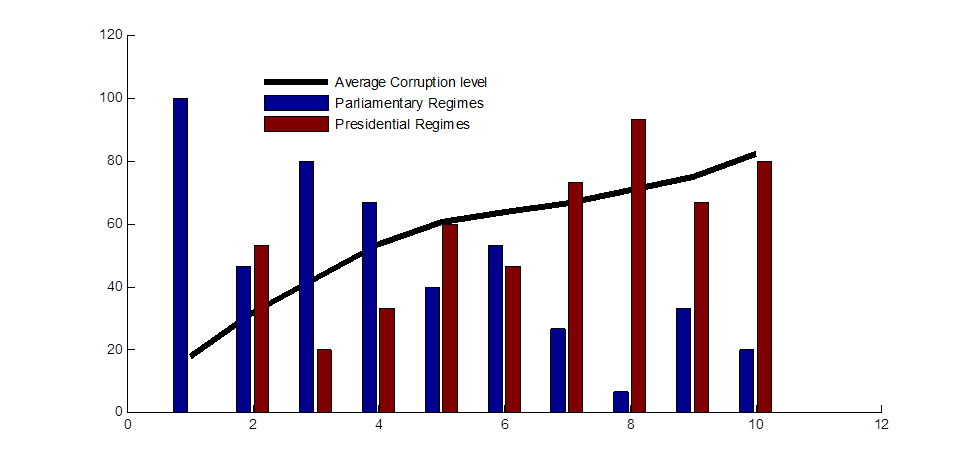In this note we carry a preliminary investigation to examine the relationship between the corruption level in a given economy and the nature of the political regime it governs. We consider a set of 150 countries, 71 of which have a parliamentary regime in place and the rest (79) are governed by a presidential (or semi-presidential) political system, as of December 2013. Monarchies, totalitarian single party and theocracy regimes are ruled out from data.
The corruption level is measured through the Corruption Perceptions Index (CPI) of 2013. The CPI was launched by Transparency International in 1995. The CPI focuses on the level of corruption in the public sector in each country by conducting sentiment analysis based on a periodic survey of informed analysts, businesspeople and experts in countries around the world. A country with high CPI value is a clean economy with low corruption level. In this note, and for simplicity, we define the corruption level (PL) as 100-CPI. A country with high PL is a corrupt country.

The PL measures are binned into 10 buckets in an increasing order, and for each bucket the proportion of parliamentary and presidential regimes are displayed in the plot in the above. It appears that economies governed by parliamentary regimes exhibit less corruption level than those governed by presidential or (semi-presidential) regimes.
In fact, all the 15 least corrupt countries are states with parliamentary regimes: Finland, New Zealand, Sweden, Singapore, Australia, Norway, Canada, Netherlands, Iceland, Luxembourg, Germany, Barbados, Belgium, Japan, and United Kingdom. The most corrupt 15 countries’ bucket contains 3 parliamentary regimes only: Libya Somalia and Iraq. The remaining are: Tajikistan, Democratic Republic of the Congo, Equatorial Guinea, Zimbabwe, Burundi, Chad, Haiti, Venezuela, Turkmenistan, Uzbekistan, Myanmar, and Sudan.
The central fifth bucket, where Tunisia belongs, contains 6 parliamentary regimes (Italy, Bulgaria, Montenegro, Serbia, Trinidad and Tobago, Jamaica) and 9 presidential regimes (Sao Tome and Principe, Liberia, Tunisia, Sri Lanka, Burkina Faso, El Salvador, Panama, Peru, Malawi). In this analysis, Tunisia is considered a semi-presidential country.
The present chart of the week does not intend to build any causal relationship between the corruption level and the nature of the political regime governing the economy. It is primary aim is to report an observable association between the two variables.
Note Prepared By: Oualid Missaoui, Ph.D TUNESS Research Team
